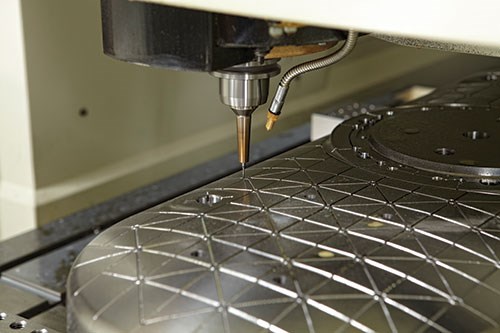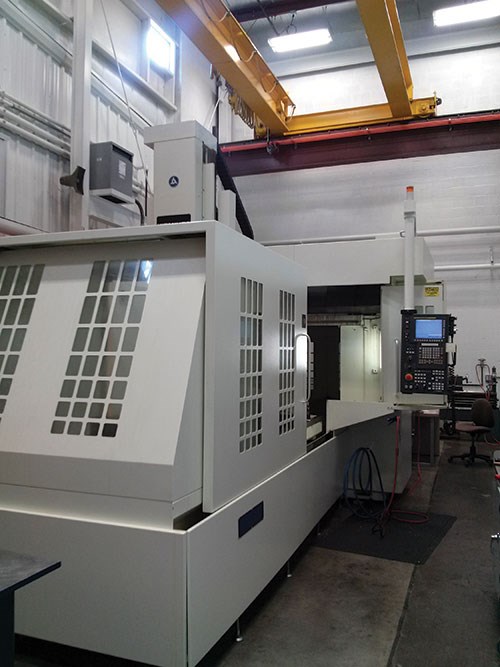No Compromises for Large-Mold Machining
Two double-column bridge-type VMCs reduced this operation’s reliance on outside suppliers without requiring trade-offs between power and precision.
For intricate details and finishing work, 5,000 rpm just wasn’t cutting it.
It’s not as if the toolroom at EVCO Plastics’ headquarters facility didn’t have faster spindles at its disposal. The Makino VMCs that handle most of the milling at the DeForest, Wisconsin, operation can achieve 20,000 rpm. However, speed wasn’t the only limitation. Weight and size capacity were often the chief factors driving the company to outsource, says Jim Kollath, corporate tooling manager. Better supporting EVCO’s global plastic injection molding business would require equipment with the versatility to handle both heavy hogging and tolerances ranging to ±0.0005 inch on molds as heavy as 16,000 pounds.
With a larger work envelope and a spindle speed matching that of the shop’s smaller workhorse machinery, the Bridgecenter-8F from Kitamura has fulfilled both requirements. Other benefits cited by Phil Anderson, toolroom supervisor, include less operator intervention and additional design freedom for larger molds. In fact, EVCO was pleased enough with the double-column, bridge-type machining center that it opted for another, larger model from Kitamura, a Bridgecenter-10, when it moved to expand size capacity for a second time.
A Critical Supporting Role
Regularly processing core and cavity blocks weighing as much as 8,000 pounds apiece is new ground for the shop's 12-man team. Yet, such parts aren’t all that large in the context of the overall operation, Kollath says. The 6,500-square-foot toolroom is just one small facet of a 900-plus-employee company with nine injection molding facilities—four in Wisconsin, one in Georgia, three in Mexico and one in China—that churn out plastic parts for the medical, packaging, consumer products, construction and agricultural industries, among others. Presses sitting just down the hall from the toolroom at the 70,000-square-foot headquarters facility offer capacities ranging to 2,000 tons. Among the company’s largest presses are two 3,500-ton behemoths at its 100,000-square-foot operation in Oshkosh, Wisconsin. This equipment employs tools that exceed the DeForest shop’s size limits, even with the new Kitamuras.
Nonetheless, the greater the variety of tooling that can be produced in-house, the better, Kollath says. After all, mold design and building is one of the company’s five “keys to success” for ensuring optimal, cost-effective performance of plastic parts. Those tasks fall largely to Kollath and his team, who support the four Wisconsin facilities with new molds as well as repair and maintenance services on all tools, regardless of the manufacturer. Given that the operation’s importance to the overall company exceeds its relative size, EVCO Plastics President Dale Evans was quick to act on long-standing plans to expand the toolroom’s capacity once the timing was right.
Power and Finesse Combined
Kollath points out that EVCO’s molding business isn’t limited to large parts. New builds and maintenance and repair operations alike commonly involve tooling designed for presses as small as 28 tons. Nonetheless, he says there has been a marked trend in recent years toward jobs that exceed the size capacity of what was once the shop’s largest machine, a C-frame vertical with X-, Y- and Z-axis travels of 50 × 24 × 30 inches.
In contrast, the Bridgecenter-8F offers X-, Y- and Z-axis travels of 80 × 42.7 × 28 inches across a 35.4 × 98.4-inch table with a maximum weight capacity of 6,600 pounds. This larger work envelope enabled the shop to take on molds designed for the company’s 1,500-ton presses, a significant increase from the previous limit of 1,000 tons. Meanwhile, the machine’s multi-step, gear-driven spindle can be adjusted as needed for higher torque or higher speed to a maximum of 20,000 rpm. By comparison, the previous machine had to run at painfully slow feed rates to avoid breaking smaller tools once it moved from roughing to more intricate work, Anderson says. In many cases, unwieldy parts had to be moved to a sinker EDM instead.
Beyond Size and Speed
Kollath emphasizes that capacity and spindle speed weren’t the only limitations of that aging vertical. Upon installation in December 2011, the Bridgecenter-8F broke many of the resulting bottlenecks. For example, operators often had to let the older machine cool after roughing, then warm it back up again to find the “sweet spot” for finer details, Anderson recalls. Even then, they had to regularly compensate for thermal growth. In contrast, the Kitamura is thermally compensated through the builder’s Intelligent Advanced Control System (IAC), which uses regulating sensors and a machine-efficiency monitor to provide data on variable compensation values to the machine offsets. According to the builder, the system keeps displacement to less than 5 microns (0.0002 inch). The spindle is also chilled. As a result, operators can press “cycle start” and walk away. “They have a lot more confidence in what comes off the machine,” Anderson says.
The machine’s raw precision also limits the need for operator intervention. “We can machine highly contoured shutoff surfaces to net zero and know that they’ll mate up perfectly,” Anderson says. In some cases, the shop machines to a surface tolerance of -0.0005 to aid in venting and shutoff. As a result, operators spend far less time polishing, hand-fitting and spotting. Features contributing to this precision include the double-column, bridge-type design with slanted cross rail, rigid, solid boxway construction, and linear scale feedback in all three axes.
The machine also unlocked new, cost-saving options for the design staff. Given previous limitations for larger work, they were often forced to insert certain core and cavity features regardless of the requirements of the job. Now, the vast majority of molds that don’t specifically require inserts are machined from solid. With the exception of certain features, such as tall details that require removing large amounts of steel, machining from solid is almost always faster for the shop and less expensive for the customer, Anderson says. Such tools also perform better because they are easier to cool, he adds.
Going Bigger
The Bridgecenter-8F isn’t the only Kitamura on the floor at EVCO. The shop installed a second, larger double-column bridge-type, a Bridgecenter-10, in August 2013. Able to accommodate molds built for 2,000-ton presses, this machine features X-, Y- and Z-axis travels of 100 × 68.9 × 31.5 inches over a 54 × 118-inch table with a maximum weight capacity of 13,200 pounds. Additional Y-axis space is particularly useful, Anderson says, pointing out that potential for thermal growth tends to limit Y-axis travel on C-frame vertical machines. “Molds tend to be more square-shaped than rectangular, so the double-column, bridge-type construction is particularly well-suited for our purposes,” he says.
The new machine offers essentially the same advantages as its smaller cousin, with a few important differences. For one, maximum spindle speed of 10,000 rpm limits the machine’s capability for finer work, at least compared to the first Kitamura. However, the newer, 50-taper machine offers more power for heavy roughing than its 40-taper counterpart. With a mold large enough to justify processing on the Bridgecenter-10, power and torque are typically more important considerations anyway, Anderson says.
All in all, the two machines have not only expanded the range of work that EVCO can keep under its own roof, but also ensured that work can be processed as cost-effectively as possible, Kollath says. Yet, the team is confident that the gains won’t stop there. “We’re always learning something new,” says Pat McKearn, moldmaker, adding that the challenges of large-part machining recently led to experimentation with different cutting tools and holders. “The machine is just one part of the puzzle.”
Related Content
The Benefits of Hand Scraping
Accuracy and flatness are two benefits of hand scraping that help improve machine loop stiffness, workpiece surface finish and component geometry.
Read MoreFundamentals of Designing the Optimal Cooling System
The right mold components can help improve mold cooling and thereby produce higher-quality parts.
Read MoreTreatment and Disposal of Used Metalworking Fluids
With greater emphasis on fluid longevity and fluid recycling, it is important to remember that water-based metalworking fluids are “consumable” and have a finite life.
Read MoreHow to Eliminate Chatter
Here are techniques commonly used to combat chatter and guidelines to establish a foundation for optimizing the moldmaking process.
Read MoreRead Next
How to Use Strategic Planning Tools, Data to Manage the Human Side of Business
Q&A with Marion Wells, MMT EAB member and founder of Human Asset Management.
Read MoreHow to Use Continuing Education to Remain Competitive in Moldmaking
Continued training helps moldmakers make tooling decisions and properly use the latest cutting tool to efficiently machine high-quality molds.
Read MoreReasons to Use Fiber Lasers for Mold Cleaning
Fiber lasers offer a simplicity, speed, control and portability, minimizing mold cleaning risks.
Read More










.jpg;maxWidth=300;quality=90)





















